Yesterday, I ran the Phoenix Marathon. I didn't do well, so I am a bit disappointed.

It has been just over a year since my very first attempt at a marathon.
That was the Tucson Marathon back in December 2006. I didn't train properly
and still managed 3:51. (See my report
here.)
Personal philosophy-wise, I believe in maintaining a baseline level of fitness. No matter what the pressures in life or work, I try not to abrogate responsibility for maintaining fitness. This means reserving some inviolable core time for working out a certain number of days a week.
And as we age, this becomes increasingly important. Let ourselves go for a few months, and the road back to decent fitness is very long and discouragingly hard. So it's far preferable (and cost effective) to achieve a certain baseline level and hang on to it.
So what are the benchmarks? Well, basically, I should be able to comfortably run a marathon or do a double century (200 miles) on the bike at ANY TIME with ZERO NOTICE. In other words , if a friend says,
let's go and run a marathon tomorrow... I should be able to say:
ok sure, why not? Same goes for a double century. That'd be done on my so-called baseline or everyday fitness.
Of course, if I spent 4 months training for some specific event, I'd expect to do a lot better.
In the case of running, I decided I should test this by running a marathon every year on baseline fitness. This year, being year 2 for me, I'm actually a much smarter runner technique-wise. I was pretty clueless about running last year. So I had sizeable hopes I'd do better in Phoenix. Turns out I am still clueless. I was actually slower. 3:56.
I'm a bit bummed because:
- I bought the Evolution Running dvd, shortened my stride, had fewer ankle problems and ran faster than I'd ever run.
- The Running club at the University of Arizona had evening runs (6pm, 5pm) during the Fall semester to prepare for the marathon.
I participated in most of the runs apart from 3 or 4 weeks or so when I was either traveling or sick.
- They also had one long run per weekend at 6am. 6am was tough. I did a few of them but inconsistently. 10 miler a couple of times and a 20 miler.
- I use compression socks, which helped with calf muscle fatigue.
- I felt aerobically quite fit.
- My weight was down from a high of almost 76kg to 70kg. I didn't eat once at Fat Greek's all semester long.
Weight is very important in running. I can feel the difference each kilogram makes.
Although my upper body is similar to a runner's physique (read: sorta wimpy), overall my body is not really a runner's type. I have muscular and very heavy legs from cycling. So 70kg for me is below 10% body fat and a reasonable accomplishment.
So what went wrong?
I believe there are three limiters to performance for endurance events:
- Aerobic fitness.
- Nutrition.
- Muscle fatigue.
Basically, my muscles failed me through lack of miles/conditioning. To run a marathon successfully, one has to put in enough base miles, and I didn't have enough.
During, the race, I felt my muscles tightening up significantly shortly before halfway. Then I felt one of my quads on the verge of cramping. Later on, around mile 20, I locked up completely in the right hamstring. Last 6 miles, my calf muscles were on the verge of cramping as well. See the decline in pace reported by my iPod Nano Nike+ kit:
(Notice the distance discrepancy. My shoe sensor has the default setting. For calibration, figures have to be discounted to the 95.42% level.)
Being muscle limited, I couldn't even tax my aerobic system during the marathon at all. In other words, I couldn't make myself breathe hard because my muscles wouldn't let me run fast enough to do that.
Conditions were good. 45F at the start, warming up to 66F. Dry. Ideal running weather. The course was not totally flat but there were no hills, just one bridge near the end.
Nutrition-wise, I opted not to use my Camelbak this time to save weight. I carried Gu packets and took water and Accelerade from every water station. No trouble there. I did not run out of energy.
Results:
I'm in the 45-49 male age group. 199th out of 510 in the division. Timing chip time was 3:56:28 despite a big decline in pace towards the end due to muscle problems. I was stubborn enough to keep going and not walk, thus allowing me to sneak in under the 4 hour mark.

Lessons? I believe aerobically and nutrition-wise, I'm capable of going under 3:30 without improving my baseline aerobic fitness. However, I realize now I need a big enough distance base to acclimatize my muscles to the pounding. Unless I pay those dues, e.g. a friend says run 4 days a week religiously, I'd be restricted forever to hobbling in just under 4 hours.







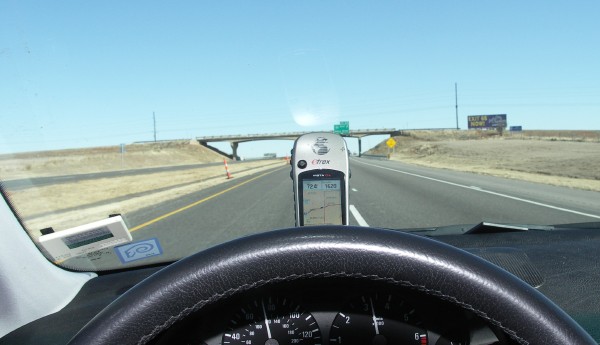


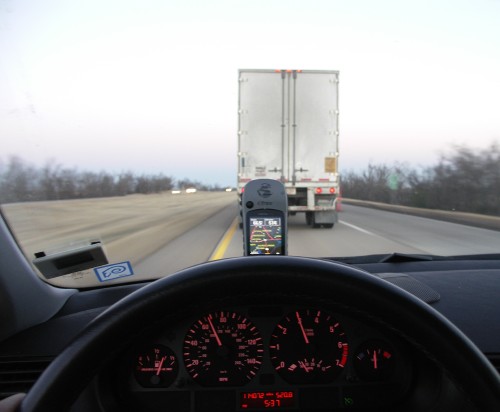
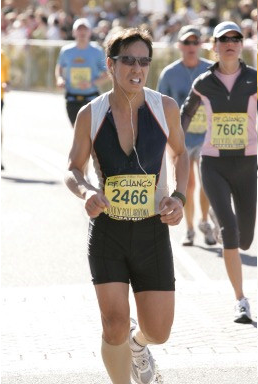
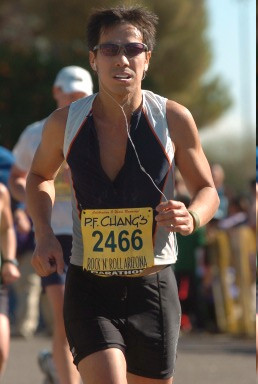
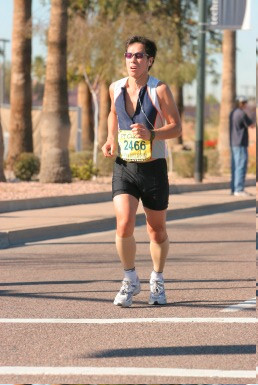 UPDATE: In the interests of full disclosure, having said all that, I went ahead and ordered the electronic download of the 2nd picture. Apparently, 1024x1536 is what they use for printing. I'll see if it stands enlargement...
UPDATE: In the interests of full disclosure, having said all that, I went ahead and ordered the electronic download of the 2nd picture. Apparently, 1024x1536 is what they use for printing. I'll see if it stands enlargement...
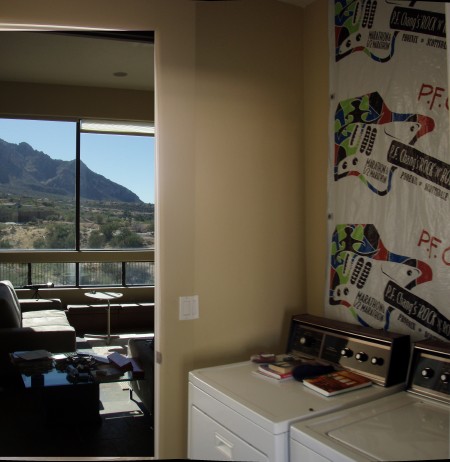

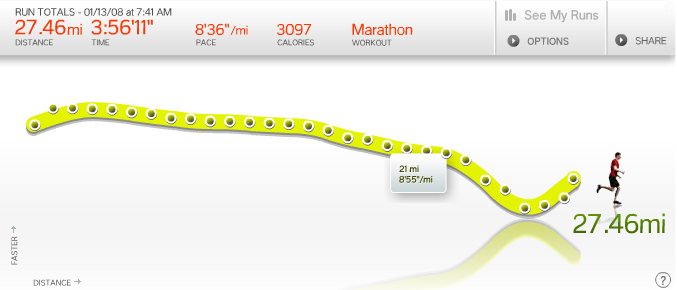

 Lessons? I believe aerobically and nutrition-wise, I'm capable of going under 3:30 without improving my baseline aerobic fitness. However, I realize now I need a big enough distance base to acclimatize my muscles to the pounding. Unless I pay those dues, e.g. a friend says run 4 days a week religiously, I'd be restricted forever to hobbling in just under 4 hours.
Lessons? I believe aerobically and nutrition-wise, I'm capable of going under 3:30 without improving my baseline aerobic fitness. However, I realize now I need a big enough distance base to acclimatize my muscles to the pounding. Unless I pay those dues, e.g. a friend says run 4 days a week religiously, I'd be restricted forever to hobbling in just under 4 hours.
